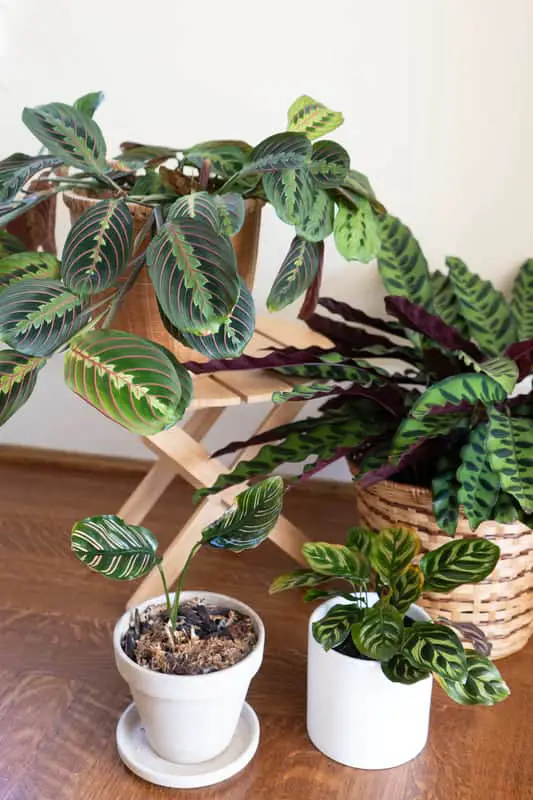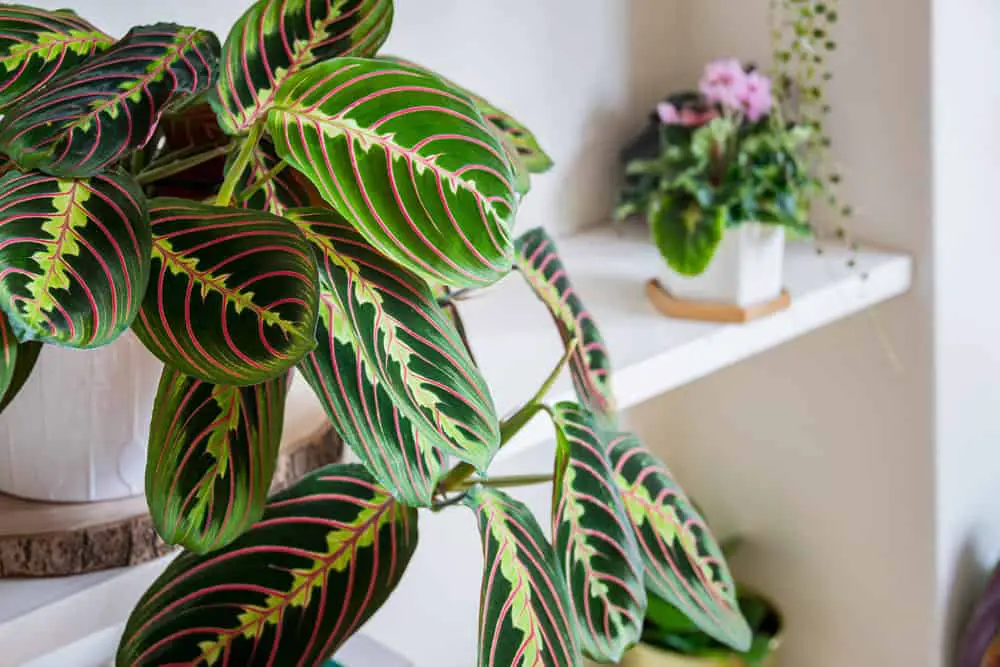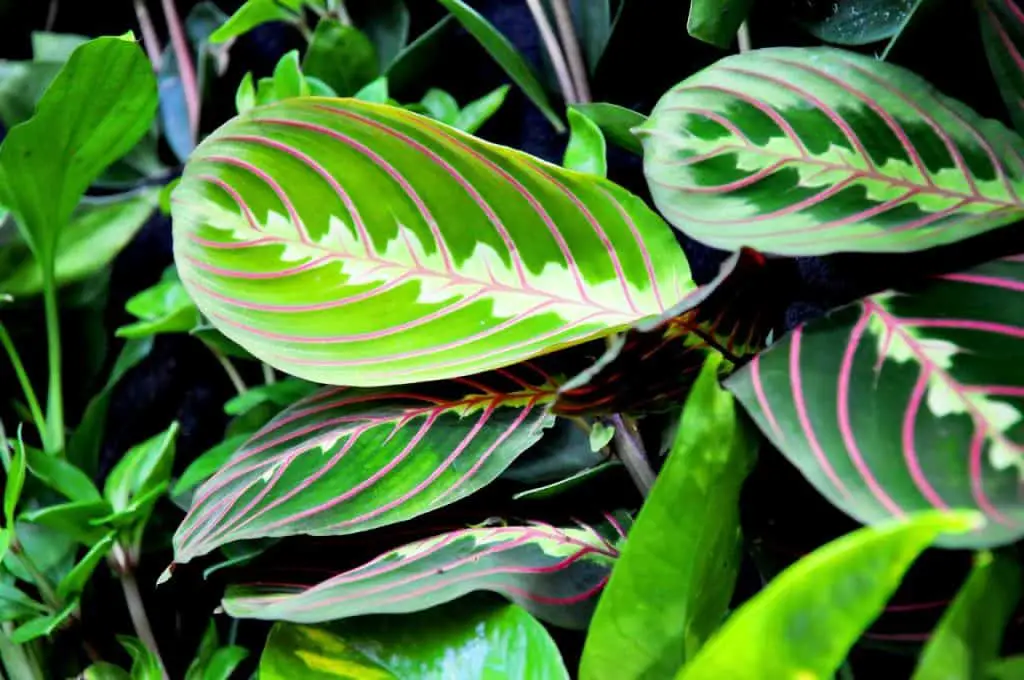The Prayer plant is a native of central and South America and grows gorgeous, colorful, patterned, oval leaves, which curl when your plant is not happy.
Prayer Plant leaves can curl due to changes in temperature or humidity, too much direct sun, or incorrect watering.
This plant prefers warm, humid environments with stable temperatures and consistent moisture levels and dislikes direct sunlight, preferring filtered light instead. To prevent leaves from curling, make sure your prayer plant is placed in a suitable environment and watered correctly.
The reasons why the leaves curl can be due to:
- Too much direct sunshine
- The temperature
- Your watering regime
- Certain pests
- Drafts or
- The lack of certain soil nutrients.
How to fix Prayer plant leaves curling?
Prayer plants originate in hot, steamy, humid conditions in the wild in countries like Brazil and Central America. Also known as Maranta’s, their gorgeous patterned leaves often show discoloration and spots due to environmental conditions. Check the symptoms below for the particular problem with your Prayer plant and see how to fix this.
The leaves of this plant could be curling due to different factors such as the following. Keep on reading to learn more about these factors and how to keep your Prayer plant happy and thriving.
Temperature
The first reason for yellow leaves is that your Prayer plant may be cold. These plants prefer to be in a daytime temperature of 55 degrees to 80 degrees Fahrenheit.
In temperatures below 60 degrees Fahrenheit, the leaves have a tendency to turn yellowish. So check the thermometer and adjust it to suit. Move the plant if it is in a draft as they don’t like this either.
Underwatering
A second reason can indicate that the conditions are too arid and dry.
During the winter period if the central heating is on and the plant is not getting enough water, the leaves turning yellow is a sure sign of a lack of humidity.
So you can mist the leaves, check for pests (see below) and water your Prayer plant properly. See Tips below.
Lack of nutrients
If it is older leaves that are yellow, it can mean a lack of magnesium whereas if the young leaves are yellow (usually between the veins), this is probably due to a lack of iron.
For both of these cases, you can fix it by re-potting your plant in new soil or use a commercial feed and apply monthly during the summer, or according to the instructions.
Pests
Mealybugs, aphids, and Red Spider mites love the leaves of this plant! The first two you can deal with by damping a cloth or cotton bud with soapy water and removing them.
Red Spider mite leaves tell-tale signs of webbing on the plant, so wipe these off and remove any insects you see but the key to removing them for good is moisture. They love dry conditions like a greenhouse normally so mist the leaves regularly and wipe them off with a cloth.
Some gardeners use Neem oil in a spray diluted with water to eradicate the pests and as a preventative measure. This will keep the dreaded leaf spot away, which can damage Prayer plants.
Prayer plant leaves curling and brown

These plants prefer indirect light so if it is summer, maybe draw a curtain at the hottest times of day to allow sifted, indirect light to reach the plant. You can also move it back a few feet away from a window.
Finally, it could be that the plant does not like the chlorine in your local water – try using boiled distilled water at room temperature and see if this helps.
Prayer plant leaves curling and drooping
Go through the list of ideal conditions and tick them off as you go.
Excessive sunlight can cause curling leaves and even sunburn, however, drooping ones may be a result of not enough water.
If the leaves start to fall off, then change your watering routine. Ensure you soak the whole root ball and that the excess can drain away easily. Read on for watering tips below.
Is the soil suitable? Ideally, this plant needs soil to be a little acidic. Check the soil you used and the soil the Prayer plant needs in the FAQs below.
Lastly, there are several pests that attack Prayer plants so check for them too.
Prayer plant leaves curling at night
The Prayer plant is famous for the way it closes its leaves together at night, resembling a person praying. So if the leaves are healthy and green, just enjoy the spectacle!
The leaves close to avoid excessive moisture from rainfall in darkness because conditions are warm and moist, which can encourage viral fungal infections to begin. If however, the curling leaves on your plant are also discolored, check the pests section below and how to water in the tips section.
Prayer plant leaves curling after re-potting
Generally, curling leaves are caused as a result of too much sunlight or under-watering.
So check all the usual things like is the plant in direct sunshine or in a draft? Is the temperature in the correct range? Check the soil requirements below in the tips section.
Sometimes newly potted plants simply need a few days to settle in.
FAQs
How do I water my Prayer plant?
Check that the soil is dry by testing with your fingertip.
If the whole pot feels dry, you know it’s time to water. You need to really soak the plant, allowing excess water to drain away and ensure that the root ball is completely moist.
If you are not confident, you can purchase a water probe or a hydrometer that will tell you exactly what the moisture content of the soil is. It should be between 40-60% humidity for them to thrive.
Drain away the excess water to prevent wet roots. Decrease watering and never fertilize in winter, as your plant is in a dormant phase.
What soil does a Prayer plant need?
Your soil should be acidic with a PH of 5.5 to 6.
Lime can be used to alter the PH if needed. It should also allow water to go through it easily; it should be loose to avoid waterlogging the roots.
Growers used to suggest 1 part loam soil plus 2 parts peat moss, but this is frowned upon now for ecological reasons. An alternative, that is ecologically sound, is to replace peat moss with coconut coir, which adds texture and nutrients.
A small amount of sand or perlite can also help drainage, which Prayer plants like. Get suitable soil from your garden center.
How do you know when a Prayer plant is dying?
Excessive direct sunshine and root rot are the common killers of the Prayer plant.
- Sunshine is the problem if the tips of the leaves are curling and wilting; think of treatment for sunburn. If the whole plant begins to turn brown, then move it quickly.
- To find out if you have root rot, you will need to carefully remove the whole plant and investigate the roots. If they are not the normal whitish color but yellow and smelly, you have found the problem.
How do I revive my Prayer plant?
- Root rot: If the reason is overwatering, then stop immediately and lift the plant from its pot allowing it to dry thoroughly.
- Next, check the light. Direct sunlight can cause sunburned leaves so if you can, move the pot to a less sunny location. Make sure you keep the plant out of direct sunlight until the winter arrives so you allow it to recover in a shadier place.
- The drainage in a pot follows after this. This is the time to re-pot, taking care to check there is good drainage and adding new soil. So let the plant dry out completely, then re-pot using the best soil you can and also ensure that there is excellent drainage. Use a terracotta pot or a porous one.
- See the best soil for a Prayer plant in FAQs.
- If the leaves are wilted, mist them next. If the leaves are brown, it is probably best to cut them off and allow the plant to direct its growing energy to new growth.
- Water using the instructions above. Then, just wait for a few days to allow the plant time to become used to its new conditions.
- Last but not least, join in the praying action of your plant’s leaves and send it some love!


